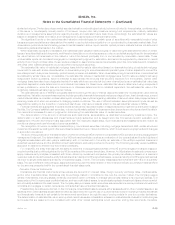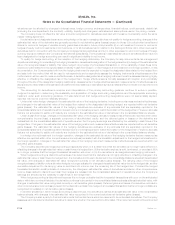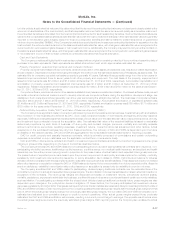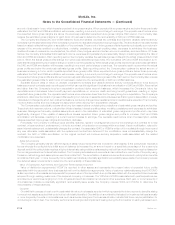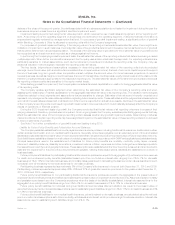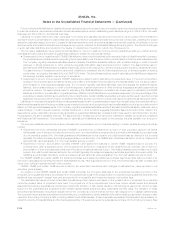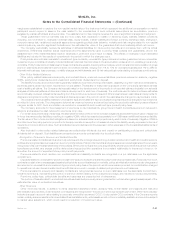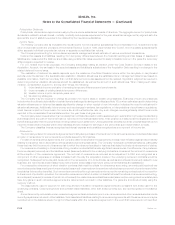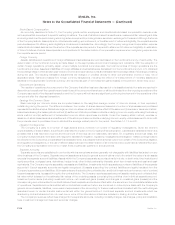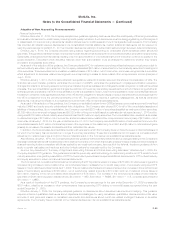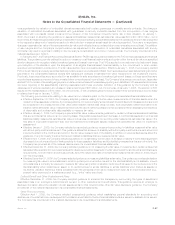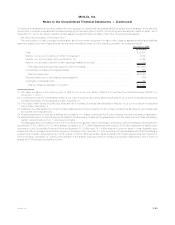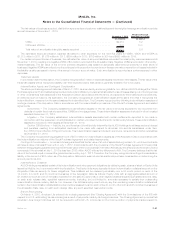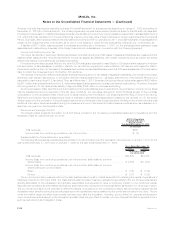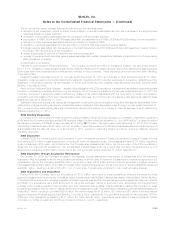MetLife 2010 Annual Report Download - page 114
Download and view the complete annual report
Please find page 114 of the 2010 MetLife annual report below. You can navigate through the pages in the report by either clicking on the pages listed below, or by using the keyword search tool below to find specific information within the annual report.Adoption of New Accounting Pronouncements
Financial Instruments
Effective December 31, 2010, the Company adopted new guidance regarding disclosures about the credit quality of financing receivables
and valuation allowances for credit losses, including credit quality indicators. Such disclosures must be disaggregated by portfolio segment
or class based on how a company develops its valuation allowances for credit losses and how it manages its credit exposure. The Company
has provided all material required disclosures in its consolidated financial statements. Certain additional disclosures will be required for
reporting periods beginning March 31, 2011 and certain disclosures relating to troubled debt restructurings have been deferred indefinitely.
Effective July 1, 2010, the Company adopted new guidance regarding accounting for embedded credit derivatives within structured
securities. This guidance clarifies the type of embedded credit derivative that is exempt from embedded derivative bifurcation requirements.
Specifically, embedded credit derivatives resulting only from subordination of one financial instrument to another continue to qualify for the
scope exception. Embedded credit derivative features other than subordination must be analyzed to determine whether they require
bifurcation and separate accounting.
As a result of the adoption of this guidance, the Company elected FVO for certain structured securities that were previously accounted for
as fixed maturity securities. Upon adoption, the Company reclassified $50 million of securities from fixed maturity securities to trading and
other securities. These securities had cumulative unrealized losses of $10 million, net of income tax, which was recognized as a cumulative
effect adjustment to decrease retained earnings with a corresponding increase to accumulated other comprehensive income (loss) as of
July 1, 2010.
Effective January 1, 2010, the Company adopted new guidance related to financial instrument transfers and consolidation of VIEs. The
financial instrument transfer guidance eliminates the concept of a QSPE, eliminates the guaranteed mortgage securitization exception,
changes the criteria for achieving sale accounting when transferring a financial asset and changes the initial recognition of retained beneficial
interests. The new consolidation guidance changes the definition of the primary beneficiary, as well as the method of determining whether an
entity is a primary beneficiary of a VIE from a quantitative model to a qualitative model. Under the new qualitative model, the entity that has both
the ability to direct the most significant activities of the VIE and the obligation to absorb losses or receive benefits that could be significant to
the VIE is considered to be the primary beneficiary of the VIE. The guidance requires a quarterly reassessment, as well as enhanced
disclosures, including the effects of a company’s involvement with VIEs on its financial statements.
As a result of the adoption of this guidance, the Company consolidated certain former QSPEs that were previously accounted for as fixed
maturity CMBS and equity security collateralized debt obligations. The Company also elected FVO for all of the consolidated assets and
liabilities of these entities. Upon consolidation, the Company recorded $278 million of securities classified as trading and other securities,
$6,769 million of commercial mortgage loans and $6,822 million of long-term debt based on estimated fair values at January 1, 2010 and de-
recognized $179 million in fixed maturity securities and less than $1 million in equity securities. The consolidation also resulted in a decrease
in retained earnings of $12 million, net of income tax, and an increase in accumulated other comprehensive income (loss) of $42 million, net of
income tax, at January 1, 2010. For the year ended December 31, 2010, the Company recorded $426 million of net investment income on the
consolidated assets, $411 million of interest expense in other expenses on the related long-term debt, and $6 million in net investment gains
(losses) to remeasure the assets and liabilities at their estimated fair values.
In addition, the Company also deconsolidated certain partnerships for which the Company does not have the power to direct activities and
for which the Company has concluded it is no longer the primary beneficiary. These deconsolidations did not result in a cumulative effect
adjustment to retained earnings and did not have a material impact on the Company’s consolidated financial statements.
Also effective January 1, 2010, the Company adopted new guidance that indefinitely defers the above changes relating to the Company’s
interests in entities that have all the attributes of an investment company or for which it is industry practice to apply measurement principles for
financial reporting that are consistent with those applied by an investment company. As a result of the deferral, the above guidance did not
apply to certain real estate joint ventures and other limited partnership interests held by the Company.
As more fully described in “Summary of Significant Accounting Policies and Critical Accounting Estimates,” effective April 1, 2009, the
Company adopted OTTI guidance. This guidance amends the previously used methodology for determining whether an OTTI exists for fixed
maturity securities, changes the presentation of OTTI for fixed maturity securities and requires additional disclosures for OTTI on fixed maturity
and equity securities in interim and annual financial statements.
The Company’s net cumulative effect adjustment of adopting the OTTI guidance was an increase of $76 million to retained earnings with a
corresponding increase to accumulated other comprehensive loss to reclassify the noncredit loss portion of previously recognized OTTI
losses on fixed maturity securities held at April 1, 2009. This cumulative effect adjustment was comprised of an increase in the amortized cost
basis of fixed maturity securities of $126 million, net of policyholder related amounts of $10 million and net of deferred income taxes of
$40 million, resulting in the net cumulative effect adjustment of $76 million. The increase in the amortized cost basis of fixed maturity
securities of $126 million by sector was as follows: $53 million — ABS, $43 million — RMBS, $17 million — U.S. corporate securities and
$13 million — CMBS.
As a result of the adoption of the OTTI guidance, the Company’s pre-tax earnings for the year ended December 31, 2009 increased by
$857 million, offset by an increase in other comprehensive loss representing OTTI relating to noncredit losses recognized during the year
ended December 31, 2009.
Effective January 1, 2009, the Company adopted guidance on disclosures about derivative instruments and hedging. This guidance
requires enhanced qualitative disclosures about objectives and strategies for using derivatives, quantitative disclosures about fair value
amounts of and gains and losses on derivative instruments and disclosures about credit risk-related contingent features in derivative
agreements. The Company has provided all of the material disclosures in its consolidated financial statements.
F-25MetLife, Inc.
MetLife, Inc.
Notes to the Consolidated Financial Statements — (Continued)


